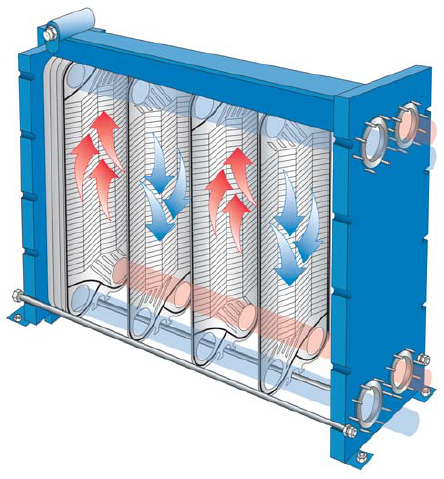Plate heat exchangers (PHEs) are a highly useful industrial component for passively (without extra energy) controlling fluid temperatures using other fluids that may already be part of the industrial process. Here’s a brief explanation of how they work and their benefits, as well as links to additional resources on plate heat exchangers.
How Does a Plate Heat Exchanger Work?
Simply put, a plate heat exchanger is a type of heat exchanger that utilizes flat metal plates to transfer heat between the fluids and plates. This is achieved when high temperature fluids pass over the plates, heat is then transferred from one side of the plate to the other, thereby removing heat from the liquid. Flat plate heat exchangers are a common design offering improved efficiency compared to tubular heat exchangers.
Plate heat exchangers are comprised of plates, also known as a plate pack, that are stacked together and closed in by two covers made of steel. The plate pack has a small distance in between the plates which allows the heat that was transferred from the fluids to circulate. This circulation process transfers heat from the plates as it flows through. Flat plate heat exchangers offer a relatively large heat transfer surface in a smaller space and can also be operated at higher liquid pressures.
Construction
Plate heat exchangers are constructed with a series of plates held together in a large frame. As you can see below, there are two inputs and two outputs, and the spaces between plates alternate between the two liquids. The large amount of surface area, as well as the metal’s corrugation contribute to much greater heat transfer than a traditional shell and tube heat exchanger of similar size. This is a well-known advantage of this technology.
Figure 1 - Exploded view of a plate heat exchanger
Materials
Depending on the types of heat exchangers used and the fluids being put through the exchanger, some materials may be better than others. For example, if you’re using seawater to cool reactor exhaust, the salt content of the brine may corrode conventional stainless steel. For an application like this, you’ll need to look into titanium plates. The same logic applies to any particularly corrosive chemicals, usually some kind of chloride compound.
Types of Plate Heat Exchangers
Welded plate heat exchangers consist of welded, corrugated heat transfer plates usually made of stainless steel. Welded plate heat exchangers were created to address some of the problems surrounding previous plate heat exchangers including gasket compatibility, as well as temperature and pressure concerns. By design, their durability makes them great for applications involving high heat or corrosive materials.
Semi-welded plate heat exchangers, as the name suggests, are welded plates still utilizing gaskets. In this design, two plates are welded together and gasketed to other pairs within the heat exchanger. Every other channel is welded together in a semi-welded plate heat exchanger and is able to handle applications where one fluid is aggressive compared to the other. Semi-welded heat exchangers are relatively easy to service and work well with applications involving more than one fluid throughout the system.
Brazed plate heat exchangers incorporate channel plates, front seal plates and connections in a design pattern of adjacent plates pointing in opposite directions. The plates are brazed together with either nickel or copper, which seals the contact points. Brazed plate heat exchangers are known to be compact and efficient. Because they can be used in applications with temperature ranges from -256 to 450°F, this type of plate heat exchanger is often used in industrial and refrigeration applications.
Gasketed plate heat exchangers use high-quality gaskets and thin corrugated metal plates compressed together within a frame. This gasket and bolt design seals plates together and protects fluids from the surrounding environment and prevents leaks. Plate heat exchangers with gaskets are easily cleaned because of the ability to readily remove plates.
Advantages of Plate Heat Exchangers
The major advantage of the plate heat exchanger design is the ability for fluids to be exposed to a larger surface area because the fluids are spread out over plates. In this, the transfer of heat is more efficiently facilitated, which allows the temperature to change more quickly. Additional advantages of plate heat exchangers include:
- More compact
- Low laminar flow
- High amounts of heat regeneration
- Relatively lower maintenance cost
- Ability to be cleaned-in-place
Modularity and Maintenance
It is fairly easy to disassemble a plate heat exchanger and then reassemble, thanks to their design. One benefit of this is modularity. If you expand your process, you don’t have to buy a new heat exchanger, simply add more plates to the one you already have. Another benefit is ease of maintenance. If your plates get fouled up, you can take it apart and clean them by hand. Or, if you have a water pump and the right chemicals, you can clean it the same way as you would a shell and tube heat exchanger.
Gasketed, Brazed or Welded?
Most plate heat exchanger manufacturers have three different ways to seal the plates together: gaskets, brazing or welding. The latter two options take away the modularity, but they add stability and reliability. That low-maintenance factor is one reason brazed plate heat exchangers are preferred in the HVAC industry, where small units are installed in combi boilers or similar heating equipment. However, gaskets are preferred in most industrial processes to allow for easier maintenance and possible expansion.
Increase Efficiency and Save Money
From wort chilling to plating and anodizing, plate heat exchangers have many applications across many industries. These units are instrumental in improving a facility's efficiency, often speeding up processes and lowering utility bills. Anthem Brewery in Oklahoma City, OK. wanted to modify a used plate heat exchanger they purchased off the open market. One of our application engineers was able to assess Anthem's current situation and design the right solution to decrease costs and increase efficiency.
For help with figuring out what plate heat exchanger might fit best for your application, contact one of our heat transfer engineers by clicking here.



